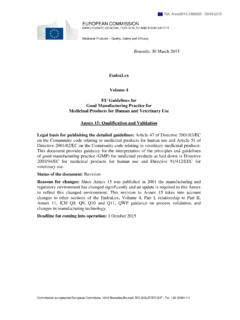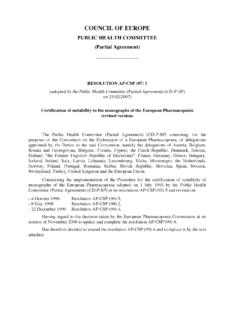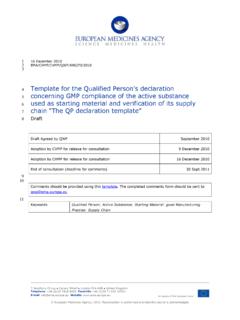Transcription of Note for Guidance on production and quality control of ...
1 The European Agency for the Evaluation of Medicinal Products Evaluation of Medicines for Human Use 7 Westferry Circus, Canary Wharf, London, E14 4HB, UK Tel. (44-20) 74 18 84 00 Fax (44-20) 74 18 85 45 E-mail: EMEA 2002 Reproduction and/or distribution of this document is authorised for non commercial purposes only provided the EMEA is acknowledged London, 24 July 2002 CPMP/BWP/3354/99 COMMITTEE FOR PROPRIETARY MEDICINAL PRODUCTS (CPMP) NOTE FOR Guidance ON production AND quality control OF animal IMMUNOGLOBULINS AND immunosera FOR HUMAN USE DISCUSSION IN THE BIOTECHNOLOGY WORKING PARTY JANUARY 1998 DECEMBER 1999 TRANSMISSION TO CPMP JANUARY 2000 RELEASE FOR CONSULTATION JANUARY 2000 DEADLINE FOR COMMENTS JULY 2000 DISCUSSION IN THE BIOTECHNOLOGY WORKING PARTY OCTOBER 2000 JUNE 2002 TRANSMISSION TO CPMP JUNE 2002 ADOPTION BY CPMP JULY 2002 DATE FOR COMING INTO OPERATION 1 AUGUST 2002 CPMP/BWP/3354/99 2/14 EMEA 2002 NOTE FOR Guidance ON production AND quality control OF animal IMMUNOGLOBULINS AND immunosera FOR HUMAN USE TABLE OF CONTENTS 1.
2 SCOPE .. 3 2. SPECIES USED FOR THE production OF animal IMMUNOGLOBULINS FOR HUMAN USE .. 4 3. CHARACTERISATION OF THE animal immunoglobulin /IMMUNOSERUM DURING DEVELOPMENT .. 4 4. POINTS TO CONSIDER IN MANUFACTURE .. 4 ANIMALS USED IN THE MANUFACTURING PROCESS .. 5 STARTING MATERIALS .. 5 production 6 5. THE FINAL BULK PRODUCT .. 8 6. THE FINISHED PRODUCT/RELEASE 9 7. CONSISTENCY OF THE MANUFACTURING PROCESS .. 10 ANNEX: POTENTIAL VIRAL 11 TABLE 1: 12 TABLE 2: HORSE .. 13 TABLE 3: SHEEP & 14 CPMP/BWP/3354/99 3/14 EMEA 2002 1. Scope animal immunoglobulin or immunoserum for human use is prepared from serum or plasma of immunised animals. Purified products consist mainly of immunoglobulin G. immunosera are at least partially purified products and could thus contain serum components other than immunoglobulins.
3 These medicinal products contain a mixture of different antibodies but are enriched in specific antibodies against a particular target antigen. The clinical targets of these products are diverse. The preparations in use include anti-lymphocyte/T-cell immunoglobulins/sera, anti-toxins against microbial and other toxins ( C. botulinum, digitalis), anti-sera against bacterial and viral agents and anti-sera against the venoms of snakes, scorpions and spiders. In general, the development of immunosera dates back to the beginning of the 20th century when they were the only available treatments for certain life-threatening conditions. In fact, this is still the case for most of these products. In general, animal immunoglobulins and immunosera are used infrequently and in very few patients.
4 However, the anti-lymphocyte immunoglobulins/sera product group is still important and routinely used in the prophylaxis and treatment of acute rejection episodes in organ transplantations, for the treatment of GvHD in bone marrow transplantations and in the therapy of aplastic anaemia. New developments include immunosera produced from the yolk of immunised hens, for example for the treatment of diarrhoea caused by parasites in AIDS patients. animal immunoglobulins/ immunosera are administered intramuscularly, subcutaneously or intravenously. Some products are diluted in large volumes of physiological solutions before infusion. The first products consisted of crude sera, which were replaced by purified immunosera as required by the relevant Ph. Eur.
5 Monograph. These early products were purified by precipitation, often consisted of complete antibodies and may contain serum components other than immunglobulins. The manufacturing processes of more recently developed products include more effective purification steps. Products are available with active substances consisting of purified F(ab )2 or Fab immunoglobulin fragments produced by pepsin or papain digestion of complete immunoglobulin molecules. In this document, the requirements for animal immunoglobulins/ immunosera for therapeutic use in humans are outlined. animal immunoglobulins/ immunosera to be used for diagnostic purposes in vitro are not the concern of this note for Guidance . Those products intended for use in the purification of other products, by immunoaffinity columns should be shown to be pure and free from adventitious agents by the methods described.
6 Important considerations for the clinical use of animal immunoglobulins/ immunosera include the risk of sensitisation of the recipient, the need of preparations with sufficient purity, the viral and TSE safety aspects, adverse effects caused by additives, pyrogens, cell or complement-active aggregates or immune complexes and variability in the specific potency. Therefore, there is a need to use improved manufacturing processes to reduce the amount of heterologous protein, to remove aggregates, to ensure viral safety and to develop appropriate control methods. The quality of animal immunoglobulins/ immunosera should be considered on a case-by-case basis taking into account the individual character of each product, the clinical indication and the availability of alternative products.
7 Reference is made to the general monograph immunosera ad Usum Humanum, 0084, and to the monographs available for a number of specific immunosera (Immunoserum botulinum, 0085; Immunoserum diphthericum, 0086; Immunoserum gangraenicum, Cl. novyi, 0087; Cl. perfringens, 0088, Cl. septicum, 0089; Immunoserum gangraenicum, mixtum, 0090; Immunoserum contra venena viperarum europaearum, 0145, Anti-T-lymphocyte CPMP/BWP/3354/99 4/14 EMEA 2002 immunoglobulin for human use, animal , 1928). 2. Species used for the production of animal Immunoglobulins for Human Use animal immunoglobulins/ immunosera are obtained from sera of different species. Currently, these sera are collected from rabbit, horse, goat and sheep. Other species, like hens, could additionally be used. In general, it is desirable to have alternative products available from sera of different species for use in patients in the event of intolerance against heterologous protein.
8 Specific and general requirements for the animals used in the manufacturing process are set out under General reference is made to the relevant Commission Directives. For those species where a TSE risk is known, the requirements specified in the EU Note for Guidance on Minimising the Risk of Transmitting animal Spongiform Encephalopathy via Human and Veterinary Medicinal Products (CPMP/BWP/410/01, rev. 1) should be considered. 3. Characterisation of the animal immunoglobulin /Immunoserum during Development The active ingredient of any new immunoglobulin /immunoserum should be characterised by chemical and biological methods. Particular attention should be paid to use a wide range of analytical techniques for exploring different physico-chemical properties of the immunoglobulin .
9 A clear difference should be made between the analytical tests performed during development in order to fully characterise the immunoglobulin , and tests performed routinely on each batch of the finished product. It should be demonstrated that the product has a characteristic pattern of antigen-binding. Desired or undesired secondary processes known to be induced after the binding with the target antigen should be investigated. It should be shown that the product consists of a defined immunoglobulin G concentration. The content of other immunoglobulin classes should be investigated The product should not contain antibodies that cross-react with human tissues to a degree that would impair clinical safety. In the event that erythrocytes were used for absorption, the level of content of haemoglobin should be demonstrated to be low.
10 The protein content, the composition of protein, the degree of aggregation and molecular fragmentation of the immunoglobulin should be determined. When human blood cells have been used for absorption, the content of haemagglutinins and haemolysins should be demonstrated to be low. The immunoreactivity of the immunoglobulin should be assessed. The specific activity of the purified immunoglobulin should be determined. 4. Points to Consider in Manufacture Most of the techniques used to manufacture anti-venoms or anti-toxin immunosera are based on the data published on tetanus and diphtheria antitoxins, ammonium sulfate precipitation, peptic digestion, thermocoagulation and aluminium gel absorption. Other products like anti-lymphocyte immunoglobulins/ immunosera are produced by combinations of chromatographic and precipitation steps.















